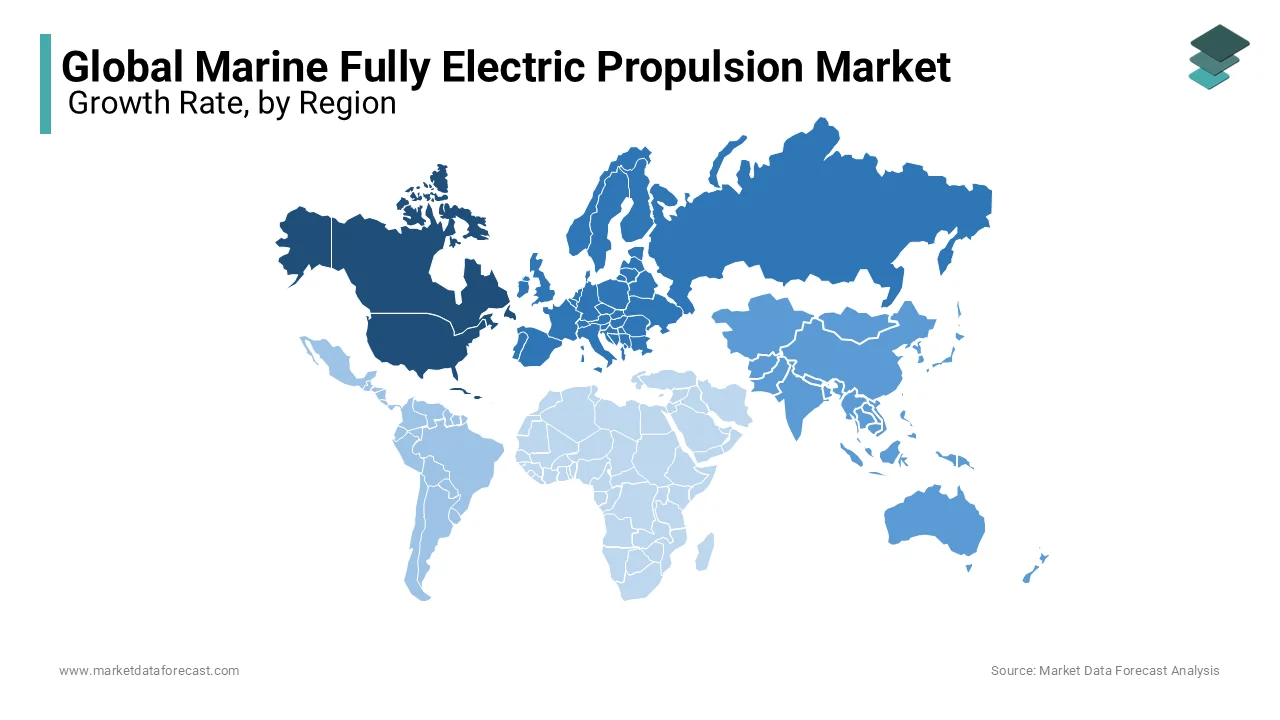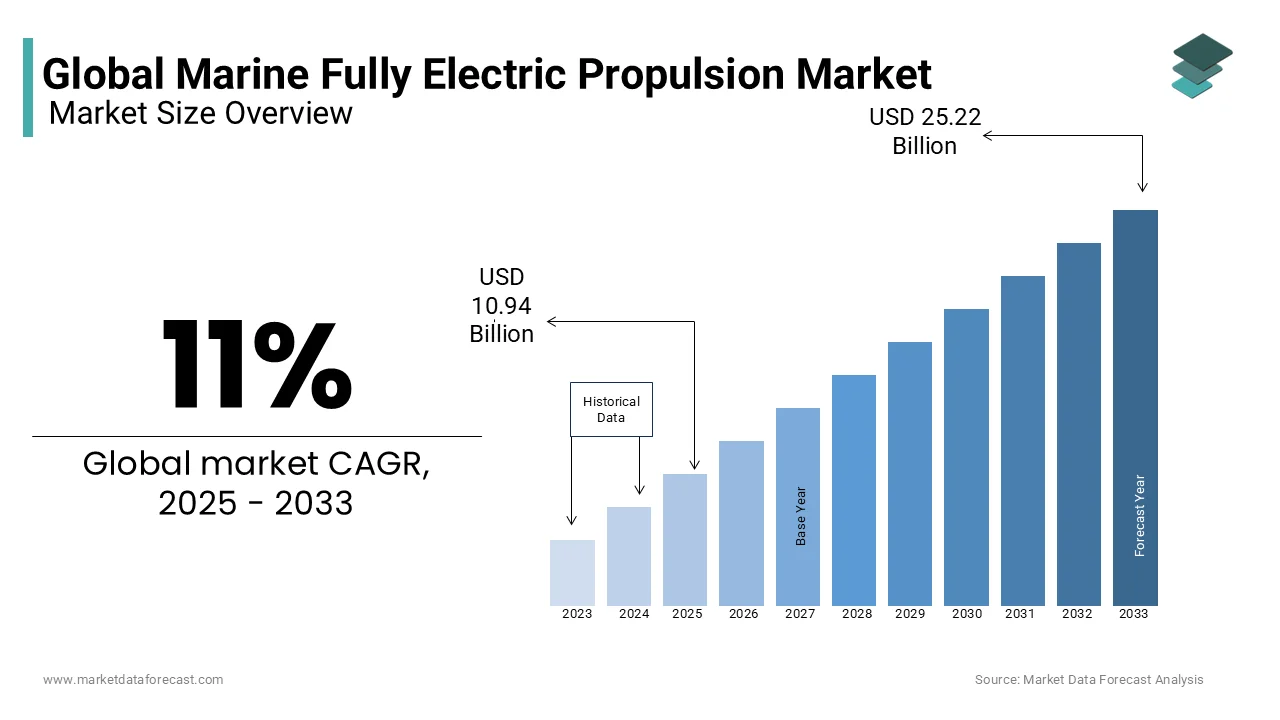Global Marine Fully Electric Propulsion Market Research Report By Ship Type (Anchor Handling Tug Supply (AHTS) Vessels, Cruise Liner, Motor Ferry, Naval Ships, Platform Supply Vessel (PSV), Small Cargo Ships, Submarines, Yachts), Deadweight (5K-10K Dead Weight Tonnage (DWT), Less Than 5K (DWT), More Than 10K (DWT)), Power Rating (Up to 1 MW, 1.1-2 MW, 2.1-3.5 MW, Above 3.5 MW), RPM (0-1,000 RPM, 1,001-2,500 RPM, Above 2,500 RPM), Application (Commercial, Logistics, Naval, Offshore Drilling) and By Region (North America, Europe, Asia Pacific, Latin America, & Middle East - Africa), Industry Forecast 2024 to 2033
Global Marine Fully Electric Propulsion Market Size
The Global Marine Fully Electric Propulsion Market was valued at USD 9.86 billion in 2024 and is predicted to reach a value of USD 25.22 billion by 2033 from USD 10.94 billion in 2025, and registering a CAGR of 11% between 2025 to 2033.
The worldwide marine market is expanding rapidly due to new innovations in the way ships are powered and operated. Marine propulsion is a system or mechanism that provides thrust for the movement of a boat or boat in the water. Modern ships are currently using mechanical systems such as a motor or a propeller based on an electric motor or impellers and propulsion pumps that are employed less frequently. Electric-powered boats are not a new concept. The first electrically powered ship was built from lead-acid batteries in France in 1881, by Gustave Found; however, energy storage limitations hampered the development of the vessel.
Generally, boat builders offer a fully electric propulsion system by custom order or upgrade. The major drivers for opting for electric propulsion systems on marine vessels are worries about water pollution. The use of renewable energy sources on board to charge the battery is likely to be another driving factor for this type of marine propulsion.
MARKET DRIVERS
The use of roads and airlines has escalated enormously for public and private transport in developed and developing countries, similarly, the use of ferries for public and private transport purposes on coastal waterways has escalated overall, complementing the market expansion. In a fully electric marine propulsion system, the engine is connected directly to the generator. The fully electric marine propulsion increases the efficiency of the boat and reduces the carbon footprint. The implementation of strict regulations by the governments of several countries, related to the elimination of harmful carbon emissions, is driving the call for hybrid and fully electric marine propulsion systems. In addition to this, the governments of various countries are financing and supporting the advancement and promoting the use of the latest technologies in marine propulsion systems.
MARKET RESTRAINTS
Contrary to the drivers, the strict rules and volatility of crude oil are affecting the expansion of the market. High initial investments and inadequate infrastructure for charging are projected to hamper the worldwide all-electric and hybrid propulsion market during the foreseen period.
MARKET OPPORTUNITIES
Several market players are actively working to develop energy-efficient marine propulsion systems. Escalating the call for small and medium-sized vessels with fuel-efficient propulsion systems employed on inland waterways is predicted to drive expansion during the foreseen period. Gradually, the escalating adaptation of marine propulsion technology is one of the key opportunities for market expansion.
REPORT COVERAGE
|
REPORT METRIC |
DETAILS |
|
Market Size Available |
2024 to 2033 |
|
Base Year |
2024 |
|
Forecast Period |
2025 to 2033 |
|
CAGR |
11% |
|
Segments Covered |
By Propulsion Type, Ship Type, Deadweight, Power Rating, RPM, Application, and Region. |
|
Various Analyses Covered |
Global, Regional & Country Level Analysis, Segment-Level Analysis, DROC, PESTLE Analysis, Porter’s Five Forces Analysis, Competitive Landscape, Analyst Overview of Investment Opportunities |
|
Regions Covered |
North America, Europe, APAC, Latin America, Middle East & Africa |
|
Market Leaders Profiled |
ABB Group, Rolls-Royce Plc, Wärtsilä, Yanmar Co., Ltd., Caterpillar, Oceanvolt, Hyundai Heavy Industries Co., Ltd, and Others. |
SEGMENTAL ANALYSIS
By Propulsion Type Insights
Depending on the type of propulsion, the fully electric boat segment is projected to grow with significant market share over the foreseen period as watercraft are powered by high-speed diesel engines and electrically powered boats have been employed in a significant way.

By Ship Type Insights
The defense sector has always been the area of greatest concern for both developed and developing countries. These countries are investing enormous capital in the defense sector. The Asia Pacific region is experiencing a high call for hybrid and all-electric marine propulsion systems due to escalated maritime trade, escalating numbers of new ship manufacturers, and greater adaptation of hybrid or all-electric propulsion systems as they upgrade existing vessels.
REGIONAL ANALYSIS
North America is projected to have a substantial share of the worldwide all-electric marine propulsion market during the foreseen period. Europe is predicted to follow North America during the foreseen period. However, the Asia Pacific market is likely to expand at a significant expansion rate during the foreseen period.

The Asia Pacific is projected to be a very lucrative region of the worldwide marine hybrid and all-electric propulsion market during the foreseen period. Investments in the shipping industry have escalated significantly in the region in recent years due to the increase in maritime trade in countries such as China and Japan. This is predicted to drive the all-electric and hybrid marine propulsion market in the Asia Pacific. North America is also a key region in terms of adopting alternative marine energy, as it helps reduce greenhouse gas emissions. Countries in the region have enacted strict regulations to reduce air pollution in coastal areas. North America is estimated to be a lucrative region of the worldwide marine hybrid and all-electric propulsion market during the foreseen period.
KEY PLAYERS IN THE MARKET
Companies playing a prominent role in the global marine fully electric propulsion market include ABB Group, Rolls-Royce Plc, Wärtsilä, Yanmar Co., Ltd., Caterpillar, Oceanvolt, Hyundai Heavy Industries Co., Ltd, and Others.
MARKET SEGMENTATION
This research report on the global marine fully electric propulsion market has been segmented and sub-segmented based on propulsion type, ship type, deadweight, power rating, rpm, application, and region.
By Propulsion Type
- Hybrid Vessel
- Full Electric Vessel
By Ship Type
- Anchor Handling Tug Supply (AHTS) Vessels
- Cruise Liner
- Motor Ferry
- Naval Ships
- Platform Supply Vessel (PSV)
- Small Cargo Ships
- Submarines
- Yachts
By Deadweight
- 5K-10K Dead Weight Tonnage (DWT)
- Less Than 5K (DWT)
- More Than 10K (DWT)
By Power Rating
- Up to 1 MW
- 1.1-2 MW
- 2.1-3.5 MW
- Above 3.5 MW
By RPM
- 0-1,000 RPM
- 1,001-2,500 RPM
- Above 2,500 RPM
By Application
- Commercial
- Logistics
- Naval
- Offshore Drilling
By Region
- North America
- Europe
- Asia Pacific
- Latin America
- Middle East & Africa
Frequently Asked Questions
What is the Marine Fully Electric Propulsion Market growth rate during the projection period?
The Global Marine Fully Electric Propulsion Market is expected to grow with a CAGR of 11% between 2025-2033.
What can be the total Marine Fully Electric Propulsion Market value?
The Global Marine Fully Electric Propulsion Market size is expected to reach a revised size of USD 25.22 billion by 2033.
Name any three Marine Fully Electric Propulsion Market key players?
ABB Group, Rolls-Royce Plc, and Wärtsilä are the three Marine Fully Electric Propulsion Market key players.
Related Reports
Access the study in MULTIPLE FORMATS
Purchase options starting from
$ 2500
Didn’t find what you’re looking for?
TALK TO OUR ANALYST TEAM
Need something within your budget?
NO WORRIES! WE GOT YOU COVERED!
Call us on: +1 888 702 9696 (U.S Toll Free)
Write to us: sales@marketdataforecast.com
